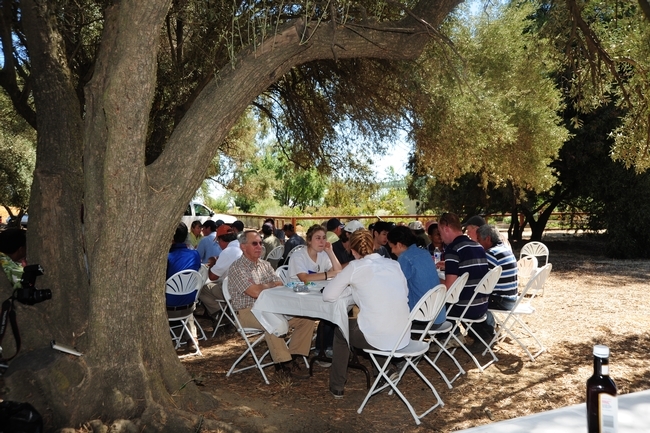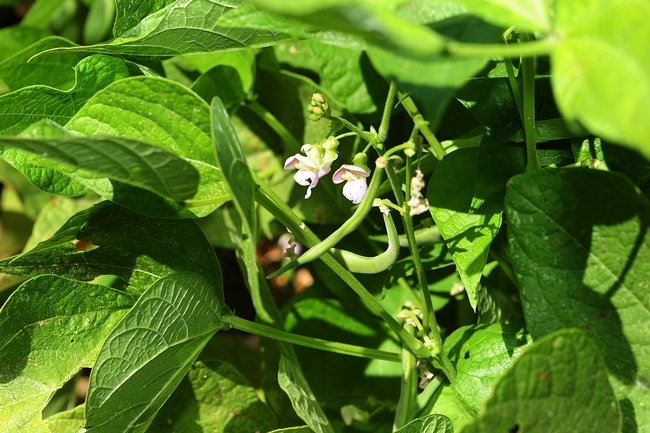- Author: Michelle Leinfelder-Miles
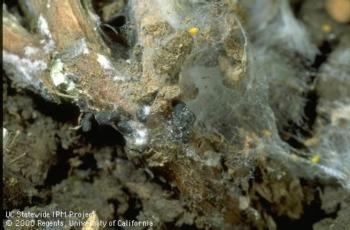
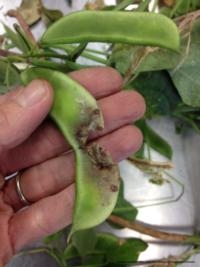
I later visited the field with the PCA in order to assess the situation for myself. The disease appeared to be most apparent in one corner of the field where the water tends to sit a little longer. (This is a furrow irrigated field that has had beans for several consecutive years.) Moist or humid conditions favor white mold, as do heavy canopies. The leaves were showing some unusual brown lesions, and some plants had white mycelium growing on the pods (Figure 2). The most detrimental symptom that we observed, however, was complete infection of the stem at the soil line, causing the tissue to dry up (Figure 3). In this case, the upper canopy looked ok, but I am uncertain, perhaps doubtful that the pods will fill on these plants.
What we can hope is that the disease won't appear on more plants in the next two weeks because there are really no management strategies at this stage in the game. The grower needs to think about how to manage this disease in the future, and rotating out of beans to a non-host crop (like small grains or corn) is probably a good strategy.
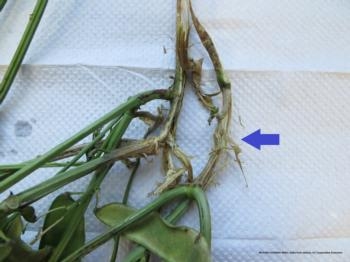
If wider row spacing is an option, this can also improve air movement in the canopy, which makes conditions less favorable for white mold. Monitoring for the disease should begin at flowering, which is also the best time to apply fungicides (like thiophanate methyl or boscalid) because the plants are small enough for the treatment to penetrate into the canopy.
- Author: Michelle M Leinfelder

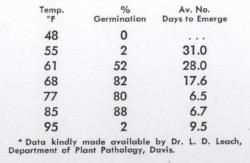
In addition to the production manuals previously mentioned, I also consulted UC production manuals produced in the 1950's, including Dry Edible Bean Production in California (1954), Blackeyes: Costs of Production, Suggestions on Growing (1956), and Production of Dry Edible Lima Beans in California (~1951).
- Author: Michelle M Leinfelder
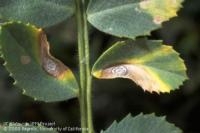
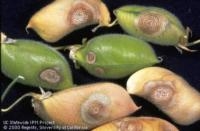
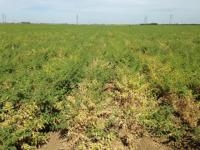
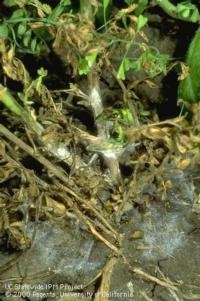
A pest control advisor recently contacted us to ask what pests he should be scouting for in garbanzo beans. His clients had not grown garbanzos in the past but have some acreage this year. Given recent wet weather and relatively mild temperatures, there are three diseases for which we suggest keeping an eye out.
Ascochyta blight (Ascochyta rabiei, Didymella rabiei) is a particular problem in garbanzo beans in wet years, like what we've been having this year. Ascochyta blight can occur at any stage of growth and on any aerial part of the plant. Brown lesions on the stems can cause damping-off symptoms in seedlings or can cause stems to break. At the advanced stage of the disease, concentric circles of spores will form within brown leaf lesions, and these are a good diagnostic characteristic (Figure 1). These concentric circles can also be seen on seed pods (Figure 2), which can result in poor seed set, seed discoloration, and shrinkage. If these beans are used for seed, subsequent crops can get infected. Management of Ascochyta is through the use of tolerant varieties, crop rotations, certified disease-free seed, always using a seed treatment (Mertect), and foliar fungicides. Foliar fungicides, such as Headline or Quadris, should be applied at the first sign of the disease and reapplied if rainy weather is forecasted.
Alfalfa mosaic virus is another disease that could infect garbanzo beans. Alfalfa mosaic virus has a wide host range and is transmitted by aphids. Different strains of the virus may cause symptoms as varied as necrotic spots on leaves to yellow dots or mottling on the entire plant, which can stunt plants or result in pod distortion. Treatment is not recommended for either alfalfa mosaic virus or for the aphids that vector it. Aphids may taste the garbanzo plants but are either killed or deterred by the acidic exudate of the plant, so it is not economical to treat for them. Instead, planting date is important to avoid aphid flights. There are no patterns of infection in fields. Infected aphids land on plants, transmit the disease and then die, so healthy and dying plants may be next to each other (Figure 3).
Lastly, white mold (Sclerotinia sclerotiorum and S. trifoliorum) may be a problem in garbanzos this year, like Ascochyta blight, because of the wet conditions. White mold may appear as a watery rot on stems, leaves, and pods. White mycelium may grow on the stem near the soil line where conditions are moist (Figure 4). Yellow flagging of leaf tissue may appear where stems have been killed. The fungus spreads under moderate temperatures and especially where canopies are dense. Management is through rotations with non-host crops (small grains, corn), and by applying fungicides, such as Endura, during the flowering stage.
Information on products and practices is for educational purposes only and does not constitute an endorsement or recommendation by the University of California.
- Author: Rachael Long
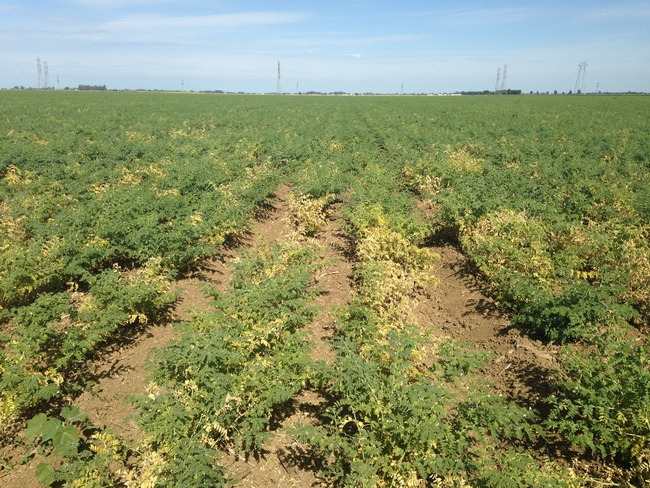
It is not cost effective to spray the aphids for virus control; instead, planting date is important to avoid aphid flights. The best time to plant garbanzos in California is November 15 to January 15 to take advantage of winter rainfall for irrigation. Garbanzos can also be planted in the spring from April 20 through May.
These later plantings (for both winter and spring seeding times) are needed to help avoid the seed corn maggot, a serious pest of beans, and aphid flights that can vector a number of devastating viral diseases. In addition, avoid planting garbanzo beans adjacent to alfalfa fields, a significant host and source of alfalfa mosaic virus.
- Author: Rachael Long
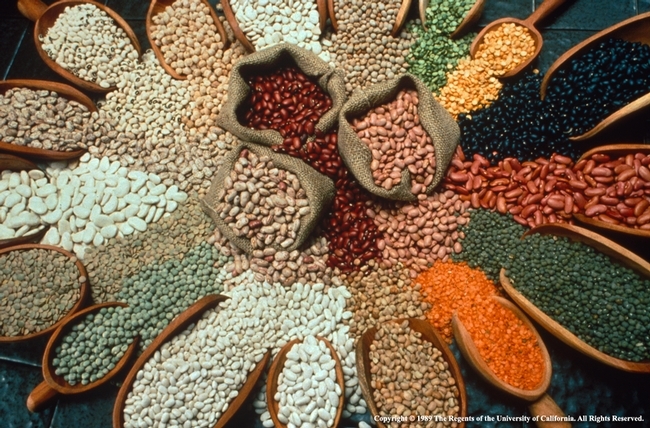
Dry beans are a big business in California. In 2011, growers harvested 45,000 acres of dry beans valued at $58 million. Lima beans accounted for about 40 percent of this total acreage, with California producing nearly 99 percent of the U.S. domestic supply of dry lima beans.
Why should we be so interested in beans? From a nutritional standpoint, dry beans are a healthy food choice - an excellent source of protein, fiber, vitamins and minerals, plus they're very low in fat. Organizations such as the American Heart Association, the American Diabetes Association and the USDA's My Plate all recommend including beans in one's diet to reduce cholesterol, maintain normal blood sugar and to maintain a healthy weight. The California Dry Bean Advisory Board posts many bean recipes on their website at http://calbeans.org/.
From a production standpoint, beans are a crucial crop for farmers. California growers produce four main classes of dry beans, including limas (large and baby), common beans (such as kidneys, pinks, whites, cranberries and blacks), garbanzos (chickpeas), and cowpeas (blackeye beans). Garbanzo beans are grown as a winter crop, while the others are produced in the summer. California's dry beans are marketed throughout the world, including Japan, Mexico, Canada, and the United Kingdom. California also grows dry bean seed stock for export to other states and international markets.
In rotation with other crops beans help control weeds, add biomass to the soil via plant matter disked into the ground after harvest, and require relatively few pesticides. In addition, beans, as legumes, fix nitrogen from the air via nitrogen-fixing bacteria that colonize the roots, forming nodules. Cowpeas, for example, fix about 100 pounds of nitrogen per acre, providing most of the nitrogen needs for this crop. Likewise, garbanzo beans require minimal nitrogen inputs for crop production. Economically, beans can enhance the annual farm profitability because common beans and cowpeas can be double-cropped with grains or forage crops, producing two crops in one year.
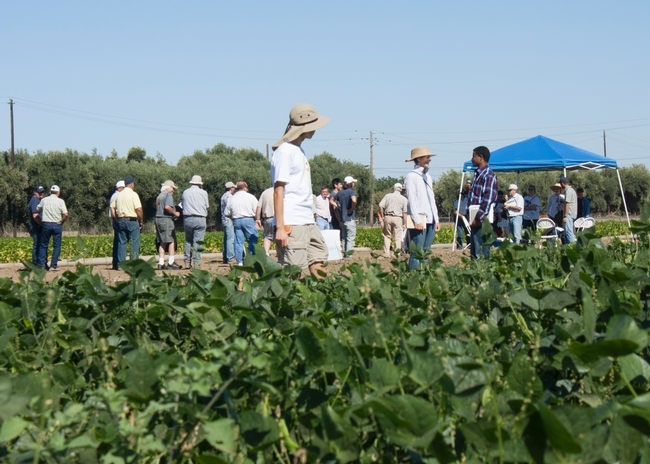
The participants learned about UC research trials, led by Paul Gepts, professor in the Department of Plant Sciences at UC Davis, focus on dry bean breeding programs for pest and disease resistance, drought tolerance, organic production, and yield and quality increases. “Dry” refers to allowing the beans to fully mature and dry on the plants, as opposed to picking the beans green as a fresh market vegetable.
Many of today's commercially grown dry beans come from University of California varieties, such as those shown at the UC Field Day. Seed germplasm for different genetic traits are selected from all over the world. The lima bean trial at UC Davis included 56 seed selection entries, the heirloom beans included 25 entries, and cranberries and pink beans had 134 entries. Earlier this year eight advanced line garbanzo entries were tested. UC Davis researchers work with hybrids produced by hand crosses to increase seed yield, quality, pest and disease resistance and plant vigor. They receive funding from a variety of sources including the California Dry Bean Advisory Board and USDA.
As shown from this field day, UC research is leading the way to ensuring that the future of California's dry bean industry remains strong. These efforts will continue to enhance sustainable farming practices in our state and provide nutritional benefits to consumers.
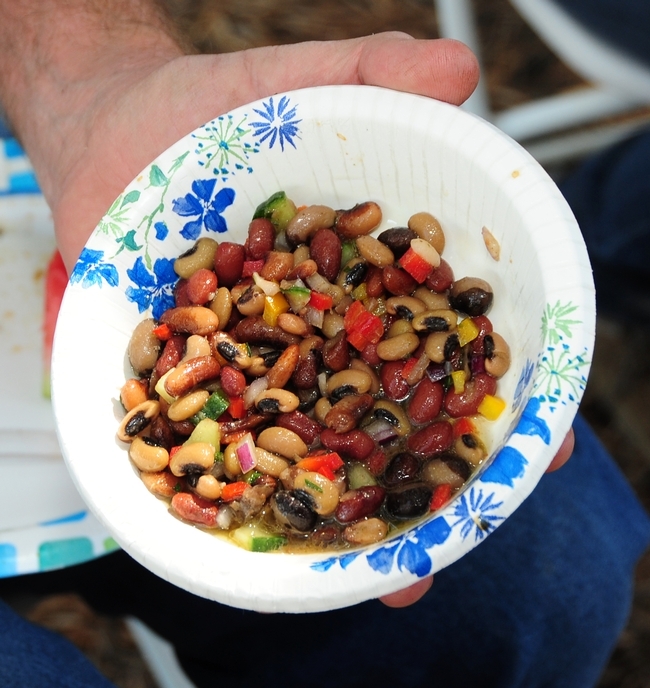
So, the next time you're in the produce section of your favorite grocery store, enjoy some California-grown beans. From the field to fork, these beans are the best of the best.
Additional resources:
Blackeye bean production in California, UC ANR publication number 21518.
Common bean production in California, UC ANR publication 8402.
